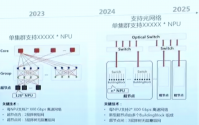broadsword
Brigadier
Can anyone give a simple summary of the hierarchy of these chips?
910B 910C H800 H100 A100 etc
Much appreciated
Wrong answer. lol
Last edited:
Can anyone give a simple summary of the hierarchy of these chips?
910B 910C H800 H100 A100 etc
Much appreciated
No.H100 > A100 > 910C > 910B
interconnect speed is limited by SERDES chips, which is actually a process node limited.The total interconnect speed of 910-B is already equivalent to that of H800, which is about 400GB/s.
interconnect speed is limited by SERDES chips, which is actually a process node limited.
I distinctly remember an Ascend slide from 2023 that showed router level speed of 8-card Ascend cluster to be 1.6TB/s, which would work out to 200GB/s between the cards.
I would certainly gladly see evidences that it is now 4.8TB/s if that's available.

interesting, but the problem looking at latest NVLink & NVSwitch set up is that H200 will increase the interconnect bandwidth to 900GB/s and Blackwell increases is to 1.8TB/sEach card has a total interconnect bandwidth of 400GB/s. In Huawei's topology each card connects to the other 7 cards in the cluster directly in a peer-to-peer fashion. So for each card that 400GB/s is devided into 7 links which goes to the other 7 cards. So the per-link speed is (400/7) = 57.14GB/s. The total number of links with in the 8-card cluster will be 28. (400/7) * 28 = 1.6TB/s.
Nvdia uses a switched topology where every card is connected to multiple switches. The practical difference is, in Huawei's topology the full 400GB/s will only be saturated when the card is talking to all other 7 cards, while in Nvidia's topology the full 400GB/s can be used between only 2 cards, because every card is connected to every other card through multiple links. Here's a hypothetical 4-card cluster (Huawei in the left, Nvidia on the right). Huawei's approach is more cost effective because the additional switching fabric is not required, but at a disadvantage for any application that would require the full 400GB/s connectivity between just 2 cards.
View attachment 136655

interesting, but the problem looking at latest NVLink & NVSwitch set up is that H200 will increase the interconnect bandwidth to 900GB/s and Blackwell increases is to 1.8TB/s
So, Huawei does have some work to do here to catch up. I looked through my slides and the best I can find in terms of where they are getting to is this. If they are still on this path, then using optical switch for their clusters might be the big innovation for Ascend-910C
interconnect speed is limited by SERDES chips, which is actually a process node limited.
I distinctly remember an Ascend slide from 2023 that showed router level speed of 8-card Ascend cluster to be 1.6TB/s, which would work out to 200GB/s between the cards.
I would certainly gladly see evidences that it is now 4.8TB/s if that's available.
This looks much worse for Cisco than Huawei. Nvidia has already started selling Ethernet and Infiniband switches with custom ASIC. Nvidia is probably a full data center solution to Huawei.interesting, but the problem looking at latest NVLink & NVSwitch set up is that H200 will increase the interconnect bandwidth to 900GB/s and Blackwell increases is to 1.8TB/s
So, Huawei does have some work to do here to catch up. I looked through my slides and the best I can find in terms of where they are getting to is this. If they are still on this path, then using optical switch for their clusters might be the big innovation for Ascend-910CView attachment 136657
